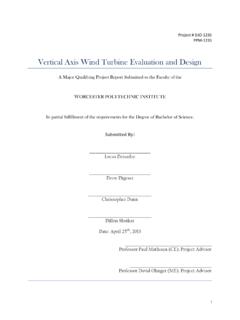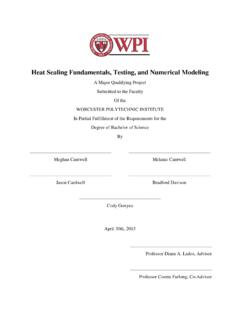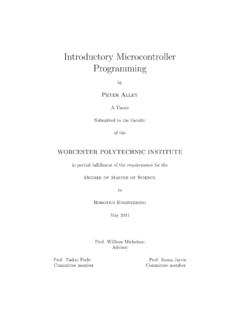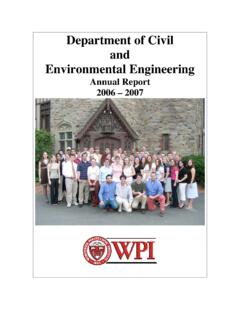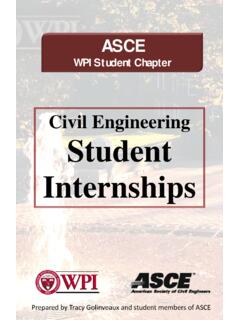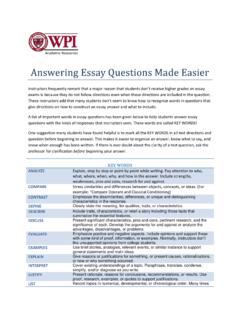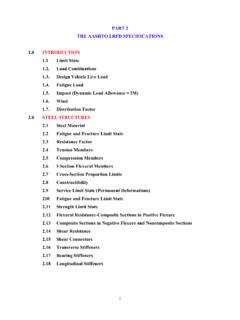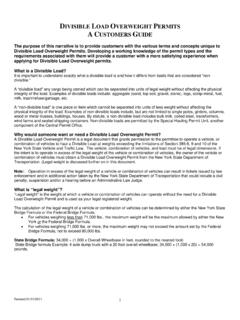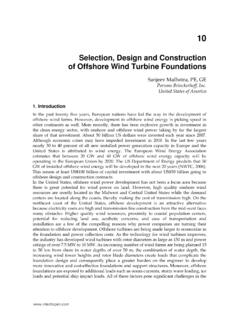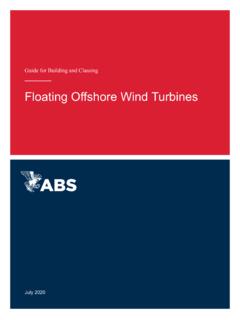Transcription of WIND TURBINE DESIGN AND IMPLEMENTATION
1 Project Number: LDA 1004 wind TURBINE DESIGN AND IMPLEMENTATION Major Qualifying Project Report: Submitted to Faculty of WORCESTER POLYTECHNIC INSTITUTE in partial fulfillment of the requirements for the Degree of Bachelor of Science By Date: March 5, 2010 Approved: Professor Leonard D. Albano, Advisor i Abstract This project examined the DESIGN of a land based wind TURBINE considering various alternatives including soil and foundation type, TURBINE size and type, tower DESIGN , type of site, and wind speeds. In addition, a cost analysis of the chosen wind TURBINE DESIGN was completed. An integrated DESIGN sheet was produced for the development of a wind TURBINE . Once the prim ary factors in the DESIGN of a land based TURBINE were determined, the implications for an offshore TURBINE were investigated. Based on research and the cost and structural analyses, conclusions and recommendations for appropriate designs were established.
2 Ii Authorship All members of the project group, Bethany Kuhn, Julie Marquis and Hilary Rotatori, made an equal contribution to the major qualifying project. The following sections were written by the specified person: Section Author Capstone DESIGN Hilary Rotatori Introduction Julie Marquis Background Bethany Kuhn, Julie Marquis, Hilary Rotatori Methodology Bethany Kuhn, Julie Marquis, Hilary Rotatori Tower DESIGN Julie Marquis Foundation DESIGN Hilary Rotatori Project Analysis Bethany Kuhn Offshore TURBINE DESIGN Bethany Kuhn, Julie Marquis, Hilary Rotatori Conclusions Julie Marquis, Hilary Rotatori iii Acknowledgements We would like to thank Frank Lagadimos, an engineer at Spartan Engineering for sharing his knowledge about the DESIGN of wind TURBINE towers. We would also like to thank Brian Kuhn, Vice President Marketing at Aeronautica wind Power for his help and knowledge about the wind TURBINE industry. Finally, we would like to thank our project advisor, Professor Leonard Albano for his advice and dedication throughout the course of our project.
3 Iv Capstone DESIGN Statement This project addressed the DESIGN constraints set by the Accreditation Board for Engineering and Technology (ABET) in order to meet the requirement of capstone DESIGN experience for the Major Qualifying Project. As stated by ABET General Criterion 4, Student must be prepared for engineering practice through the curriculum culminating in a major DESIGN experience based on the knowledge and skills acquired in earlier course work and incorporating engineering standards and realistic constraints that include most of the following considerations: economic; environmental; sustainability; manufacturability; ethical; health and safety; social; and political. 1 In addition to these constraints, this project considered the American Association of Civil Engineers (ASCE) Commentary on Engineering DESIGN . Economic One of the more important constraints on large scale civil engineering projects is economic feasibility.
4 The DESIGN of the project considered the cost of construction and the materials used. In order to ensure that the project is affordable, a cost analysis of alternative designs and materials was performed to help choose a DESIGN . A cost analysis of the final DESIGN was also conducted to determine the economic impact of the TURBINE once it is in operation. Environmental The environmental impacts of projects have been a rising concern in the civil engineering industry in recent years. It is important to protect the land surrounding the construction site and to investigate the affects of the wind TURBINE on wildlife. This project addressed environmental constraints by reviewing environmental codes and regulations regarding the construction and operation of the TURBINE . The codes that were reviewed involved studies that must be performed in order to obtain a permit for the wind TURBINE project. These studies include avian and bat interaction; wildlife, plants and wetlands studies; archaeological and historical reviews; stream crossing and soil disturbance.
5 2 This investigation allowed the group to review the typical regulations that should be considered before a TURBINE is constructed. 1 UCSC CE Department's fulfillment of the Major DESIGN Experience. (2009, February 20). 2 National wind . (September 2009), v Sustainability Sustainability is an important aspect of the DESIGN of the wind TURBINE because the DESIGN should be durable as well as economical and environmentally friendly. The installation of a wind TURBINE itself is sustainable as it is a source of renewable energy. This project addressed sustainability by considering the maintenance to be done on the TURBINE in the future. The availability of the materials used was also taken into account. By using innovative designs such as offshore turbines land can be preserved. In addition, a life cycle cost analysis was conducted, including an estimation of the payback time for the construction of the TURBINE .
6 Constructability The constructability of the project addressed the feasibility of the DESIGN and construction of the TURBINE . This project addressed this constraint by considering ease of construction when choosing building materials, and researching the most practical methods for the construction of a TURBINE tower and foundation. The group considered using standard dimensions for the tower height and cross section and a standard TURBINE power so that the TURBINE could be easily constructed and replicated if successful. In addition, the tower was designed using a modular approach to facilitate the construction process and limit the necessary site operations. Ethical In order to address the ethical constraints, the group used the principles outlined by the American Society of Civil Engineers (ASCE) Code of Ethics which states, Engineers uphold and advance the integrity, honor and dignity of the engineering profession by using their knowledge and skill for the enhancement of human welfare and the environment, being honest and impartial and serving with fidelity the public, their employers and clients, striving to increase the competence and prestige of the engineering profession, and supporting the professional and technical societies of their disciplines.
7 3 This project considered these principles in all aspects of the DESIGN and construction plans. Health and Safety In order to address health and safety considerations, a structural analysis of the tower and foundation DESIGN materials under different forces was performed. The research performed on zoning and location restrictions was considered in the DESIGN process to ensure that the TURBINE is an appropriate distance from its surroundings. 3 Code of Ethics, (September 2009), vi Social and Political Since wind energy is a relatively new technology, society has not fully embraced the idea of wind turbines being constructed in their communities. This project addressed social and political constraints by considering the process of installing a wind TURBINE in a specific community and by researching the people and steps involved. Once these processes were understood, a flow chart of the process the in terms of people or organizations who are involved was prepared.
8 In addition, the group examined case studies in order to determine strategies by which wind turbines have been successfully integrated into various communities. vii Table of Contents Abstract .. i Authorship .. ii Acknowledgements .. iii Capstone DESIGN Statement .. iv Economic .. iv Environmental .. iv Sustainability .. v Constructability .. v Ethical .. v Health and Safety .. v Social and Political .. vi Table of Contents .. vii Table of Figures .. x Table of Tables .. xi Chapter 1: Introduction .. 1 Chapter 2: Background .. 3 Harvesting wind Energy .. 3 Types of Turbines .. 4 Orientation of Axis .. 4 Power Outputs .. 5 Mechanical Operation .. 6 Initial Site Assessment .. 6 Feasibility and Permitting .. 7 Siting .. 7 Community Bylaws .. 8 Site Analysis .. 9 Social Integration of wind Turbines .. 11 Choosing a TURBINE Size .. 12 Planning Process of wind TURBINE Installation .. 13 wind TURBINE DESIGN .. 15 viii Tower .. 15 Foundation.
9 17 Chapter 3: Methodology .. 18 Chapter 4: Tower DESIGN .. 21 Loading Conditions .. 21 Axial Loads .. 21 Lateral Loads .. 22 Load DESIGN Spreadsheet .. 25 DESIGN for Stresses .. 25 Flange DESIGN .. 28 DESIGN Summary .. 28 Discussion of Data .. 30 Chapter 5: Foundation DESIGN .. 33 Footing Dimension DESIGN .. 34 DESIGN for Shear Loads .. 37 Two Way Shear .. 37 One Way Shear .. 38 DESIGN for Bearing Strength and Base Plate .. 40 DESIGN for Bending Moment Strength and Reinforcement .. 42 Foundation Dimensions .. 49 Anchor Bolt DESIGN .. 50 AutoCAD Drawings .. 52 Chapter 6: Project Analysis .. 55 Permitting .. 55 Installation .. 57 Maintenance .. 58 Project Analysis Spreadsheet .. 58 Energy Output .. 60 Financial Analysis .. 65 Sample Project Analysis .. 69 Chapter 7: Offshore TURBINE .. 70 Offshore wind TURBINE Background .. 70 ix Offshore Tower DESIGN .. 71 Offshore Foundation DESIGN .. 74 Construction of Offshore wind Turbines .. 74 Chapter 8: Conclusions.
10 76 References .. 78 Appendices .. 82 Appendix A: Project Proposal .. 83 Appendix B: Interview Notes with Aeronautica wind Power .. 84 Appendix C: Tower DESIGN Sheets and Hand Calculations .. 86 Appendix D: Tower DESIGN Alternatives .. 87 Appendix E: Foundation DESIGN Sheets and Hand Calculations .. 88 Appendix F: Foundation DESIGN Alternatives .. 89 Appendix G: Anchor Bolt DESIGN .. 90 Appendix H: Offshore wind TURBINE DESIGN Sheets and Hand Calculations .. 91 x Table of Figures Figure 1: wind Energy Production .. 3 Figure 2: A Comparison of the Horizontal Axis wind TURBINE (HAWT) and Vertical Axis wind TURBINE (VAWT) Configurations .. 5 Figure 3: Planning Process of Installing a wind TURBINE .. 14 Figure 4: Increase Factor Due to Height of Tower .. 15 Figure 5: Flow Chart of wind TURBINE DESIGN .. 19 Figure 6: wind Speed Conversion Table, Massachusetts State Building Code (780 CMR) .. 23 Figure 7: Example wind Profile Graph.

